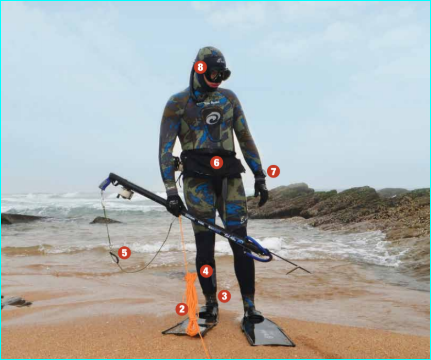
Just the other day I watched a guy fill up his booties with water, walk up the beach and rinse his feet off with the water in each bootie before putting them on. I have been shore diving for as long as I can remember and there I was learning something new, I had always been the guy looking for a rock pool to rinse my feet in.
When spearfishing you are just never too old to learn new tricks, so we thought we would nail down a few basics in this edition. Sure, this is how we do it on the KZN North Coast and there are probably a bunch of guys from the Cape no doubt, who will have a completely different approach. That’s fine as long as they share the “love” and let us know what works for them.
When shore diving one of the most common errors I see being made is how divers rig up their buoy line when swimming through the surf. For the most part guys let all the line out and head back for the back line.
This presents a number of problems:
- The buoy can get snagged in rocks.
- The buoy is in the surf impact zone for the whole length of your line. So even once you are out the back you still have to pull your body through the toughest section.
Another mistake is having a long bungee line on the buoy end. The bungee line just lets the buoy get dragged with the wave and you need to work that much harder to pull the buoy through the surf.
The best way is to have your line short and if you have a bungee line, which should be on the gun side, have it wrapped up on your gun. You can either wrap all the line up like we showed you in Volume 6 of USM.
I prefer to tie the line up; it means that as soon as I hit the back line I can easily unwrap the bungee line if I have one on and load up quickly.
The reason for having a short buoy like when swimming through the surf is simple.
- Your buoy is close to you and less likely to get washed into rocks and get snagged.
- Each time you dive under a wave your buoy follows you down under the wave and there is less drag.
You will be amazed even a big buoy will pull under a wave when you pull down on the front of the float as a wave is approaching. I guess it’s much like a surfer duck diving his surfboard under a wave.
I hope you found this helpful!
- Stop your stringer “T-boning” on the rocks and getting snagged up by putting a piece of gun rubber on the stringer line and securing the sharp end. Or if you have a foam buoy, just stab the stringer into the back of the buoy.
- Buoyline tied up like we explained in Back 2 Basics, USM Volume 6.
- Finguards are a “must” to safeguard losing your fins to the surf.
- Standard issue dive knife, you just never know when you need a good knife.
- Reef hook and reefgun setup – that’s another whole big discussion we will have soon, in an upcoming issue.
- Shuttle bag, this is not just for crayfish. This is the best way to make sure you don’t loose any gear like booties, mask, and gloves to and from the waters edge.
- Dive watch: an important tool in the shore diver’s arsenal, it’s great for helping orientate yourself on a reef by knowing exactly how deep you are.
- I know it’s more comfortable to have your mask strap on the outside of your hoodie, but if you are a novice in the surf or the surf is looking heavy, it’s a safe bet to put your mask on first and then your hoodie over the mask strap. If you get smashed you won’t loose your mask.
